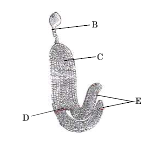Question
Easy
Solving time: 1 mins
(a) Identify the figure given below and also identify the parts B, C, D and E.

(b)State the function of E
Found 7 tutors discussing this question
Discuss this question LIVE
9 mins ago
 Text solution
Text solution Verified
Verified
a) The given figure is a mature dicot embryo. In which B-Suspensor ; C- Radicle ; D-Plumule ; E-Cotyledon
b) Function of E - Cotyledon is Storage of food reserves (as in legumes).
b) Function of E - Cotyledon is Storage of food reserves (as in legumes).
Was this solution helpful?
104
Share
Report

One destination to cover all your homework and assignment needs
Learn Practice Revision Succeed

Instant 1:1 help, 24x7
60, 000+ Expert tutors

Textbook solutions
Big idea maths, McGraw-Hill Education etc

Essay review
Get expert feedback on your essay

Schedule classes
High dosage tutoring from Dedicated 3 experts
Questions from Class 12th Board 2020 - PYQs
Question 1
Easy
Views: 5,717
Question 2
Easy
Views: 6,009
Question 3
Easy
Views: 6,118
Question 4
Easy
Views: 5,236
Practice questions from Sexual Reproduction in Flowering Plants in the same exam
Question 3
Easy
Views: 6,026
(b) How would you proceed to cross-pollinate a monoecious flower ?
(c) Draw a labelled schematic diagram of T.S. of an anther of an angiosperm.
Practice more questions from Sexual Reproduction in Flowering Plants
Question 1
Easy
Views: 5,830
Question 3
Medium
Views: 5,720
I. Endothecium lies behind epidermis
II. Fusion of egg with male gamete is called apogamy.
III. Synergids are haploid
IV. The point at which funicle touches the ovule is raphe.
Question 4
Medium
Views: 5,961
Practice questions on similar concepts asked by Filo students
Question 3
Views: 5,169
Question 4
Views: 5,822


Stuck on the question or explanation?
Connect with our Biology tutors online and get step by step solution of this question.
231 students are taking LIVE classes
| Question Text | (a) Identify the figure given below and also identify the parts B, C, D and E. (b)State the function of E |
| Updated On | Sep 8, 2023 |
| Topic | Sexual Reproduction in Flowering Plants |
| Subject | Biology |
| Class | Class 12 |
| Answer Type | Text solution:1 Video solution: 1 |
| Upvotes | 232 |
| Avg. Video Duration | 2 min |





